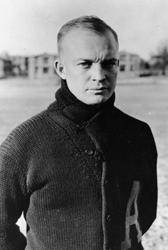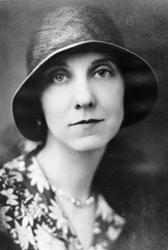DWIGHT DAVID EISENHOWER CHRONOLOGY
October 14, 1890: Ike was born in Denison, Texas, third of seven sons of David Jacob and Ida Elizabeth Stover Eisenhower.
1892: The family returned to Abilene, Kansas.
1909: Ike graduated from Abilene High School.
1909-1911: Worked at Belle Springs Creamery, 1909-1911.
June 14, 1911: Entered United States Military Academy, West Point, New York.
June 12, 1915: Graduated and commissioned a Second Lieutenant.
July 1, 1916: Married Mamie Geneva Doud of Denver, Colorado. First son, Doud Dwight, born September 24, 1917, and died January 2, 1921. Second son, John Sheldon Doud, born August 3, 1922.
1915-1920: Served with the Infantry September 1915 to February 1918 in Ft. Sam Houston, Camp Wilson and Leon Springs, Texas and Ft. Oglethorpe, Georgia. Served with the Tank Corps, February 1918 to January 1922 in Camp Meade, Maryland, Camp Colt, Pennsylvania, Camp Dix, New Jersey, Ft. Benning, Georgia, and Ft. Meade, Maryland. Promoted to First Lieutenant on July 1, 1916; Captain on May 15, 1917; Major (temporary) on June 17, 1918; and to Lieutenant Colonel (temporary) on October 14, 1918. Reverted to permanent rank of Captain on June 30, 1920 and was promoted to Major on July 2, 1920.
July 7-September 6, 1919: Volunteered to participate as a Tank Corps observer in the First Transcontinental Motor Convoy.
January 1922–September 1924: Assigned as executive officer to General Fox Conner, Camp Gaillard, Panama Canal Zone. Served in various capacities in Maryland and Colorado until August 1925.
August 19, 1925: Entered Command and General Staff School, Ft. Leavenworth, Kansas; graduated first in a class of 245, June 18, 1926.
August 1926-January 1927: Served as executive officer, 24th Infantry Regiment, Ft. Benning, Georgia.
January-August 1927: Served in Washington, DC, office, writing a guidebook to World War I battlefields for American Battle Monuments Commission, directed by General John J. Pershing.
August 27, 1927: Entered Army War College, Washington, DC, and graduated June 30, 1928.
July 1928-September 1929: In charge of guidebook revision and European office, Paris, France.
November 29, 1929-February 1933: Served as executive officer to General George V. Moseley, Assistant Secretary of War, Washington, DC.
1933-September 1935: Served as chief military aide to General Douglas MacArthur, Army Chief of Staff.
September 1935-December 1939: Assigned to General MacArthur as assistant military advisor to the Philippine Government.
July 1, 1936: Promoted to Lieutenant Colonel.
February 1940-November 1940: Assigned to General DeWitt Clinton, Commander, 15th Infantry, for a short term in Ft. Ord, California, and then permanently to Ft. Lewis, Washington as regimental executive. Chief of Staff for General Thompson, Commander, 3rd Division, Ft. Lewis until March 1941. Served as Chief of Staff to General Kenyon Joyce, Commander 9th Army Corps, Ft. Lewis, until June 1941. Designated Chief of Staff to General Walter Kreuger, Commander 3rd Army, Ft. Sam Houston, Texas, June 1941 to December 1941. Promoted to Colonel (temporary), March 11, 1941, and to Brigadier General (temporary), September 29, 1941.
December 1941-June 1942:Assigned to General Staff, Washington, DC. Named Deputy Chief in charge of Pacific Defenses under Chief of War Plans Division, General Leonard Gerow, December 1941. Designated as Chief of War Plans Division, February 1942.
March 27, 1942: Promoted to Major General (temporary).
April 1942: Appointed Assistant Chief of Staff in charge of Operations Division for General George Marshall, Chief of Staff.
May 1942: Conducted mission to increase cooperation among World War II allies, London, England. Designated Commanding General, European Theater, London, England, June 1942. Named Commander-in-Chief, Allied Forces, North Africa, November 1942.
July 7, 1942: Promoted to Lieutenant General (temporary).
February 11, 1943: Promoted to General (4 stars) (temporary).
August 30, 1943: Appointed Brigadier General (permanent) and was promoted to Major General (permanent) on the same date.
December 1943: Appointed Supreme Commander, Allied Expeditionary Forces.
June 6, 1944: Commanded forces of Normandy invasion.
December 20, 1944: Promoted to General of the Army (5 stars). Shortly after the German surrender, May 8, 1945, appointed Military Governor, U.S. Occupied Zone, Frankfurt, Germany.
November 19, 1945: Designated as Chief of Staff, U.S. Army.
April 11, 1946: Wartime rank of General of the Army converted to permanent rank.
June 7, 1948: Inaugurated as President, Columbia University, New York City.
December 16, 1950: Named Supreme Allied Commander, North Atlantic Treaty Organization, Europe, and given operational command of Treaty Organization, Europe and given operational command of U.S. Forces, Europe.
May 31, 1952: Retired from active service, and resigned his commission July 1952.
June 4, 1952: Announced his candidacy for the Republican Party nomination for President in Abilene, Kansas.
January 20, 1953-January 20, 1961: Served two terms as President of the United States; brought armistice to Korean War; promoted Atoms for Peace; dealt with crises in Lebanon, Suez, Berlin, and Hungary; established the U.S. Information Agency; created the Federal Council on Aging; saw Alaska and Hawaii become states; authorized the St. Lawrence Seaway and the Interstate Highway System; signed the 1957 Civil Rights Act, the first civil rights legislation since end of Civil War; sent federal troops to enforce court-ordered integration of Little Rock Central High School; signed the bill creating the National Aeronautics and Space Administration.
January 17, 1961: Delivered his famous Farewell Address warning the nation of the “military-industrial complex.”
March 1961: By Public Law 87-3, signed by President John F. Kennedy, Eisenhower returned to active list of regular Army with rank of General of the Army from December 1944.
January 1961-March 1969: Maintained office at Gettysburg College and residence at his farm near Gettysburg, Pennsylvania.
March 28, 1969: Died at Walter Reed Army Hospital in Washington, DC.
April 2, 1969: Buried in the Place of Meditation at the Eisenhower Presidential Library in Abilene, Kansas.
MAMIE DOUD EISENHOWER
November 14, 1896: Mamie Geneva Doud was born in Boone, Iowa, the daughter of John Sheldon and Elivera Mathilda Carlson Doud.
August 1897: The family moved to Cedar Rapids, Iowa. At age six, she moved with her family to Pueblo, Colorado, and then to Colorado Springs. They lived in each of these places only a short time, and in 1905 moved to Denver. The house at 750 Lafayette remained in the family until after the death of Mamie's mother in 1960. Mamie Doud attended Denver public schools and Miss Wolcott's, a private finishing school attended by daughters of many prominent Denver families.
October 1915: Mamie met the then Second Lieutenant Dwight D. Eisenhower while visiting friends at Fort Sam Houston, Texas. The Douds had rented a house in San Antonio for the winter.
February 14, 1916: Ike and Mamie formally announced their engagement. The engagement ring was a copy of Ike's West Point ring, amethyst set in gold.
July 1, 1916: Ike and Mamie were married at noon in the Doud family home in Denver--the same day Ike received his first army promotion. They had a ten-day honeymoon, spending the first days in Colorado, then a few days visiting the Eisenhower family in Abilene, Kansas.
September 24, 1917: Their first son, Doud Dwight Eisenhower, was born. "Little Icky", as he was nicknamed, died of scarlet fever on January 2, 1921.
August 3, 1922: Their second son, John Sheldon Doud Eisenhower, was born in Denver. On July 10, 1947, he married Barbara Jean Thompson and they had four children: Dwight David Eisenhower II, born March 31, 1948; Barbara Anne, born May 30, 1949; Susan Elaine, born December 31, 1951; and Mary Jean, born December 21, 1955. There are eight Eisenhower great-grandchildren.
General and Mrs. Eisenhower lived in various army posts in the United States and around the world. From their small quarters at Fort Sam Houston, they moved to their first real home--a white pillared fraternity house at Gettysburg, Pennsylvania, where Ike commanded the Tank Corps Training Center at Camp Colt. After Camp Colt they were transferred to Camp Meade, Maryland, and then to Camp Gaillard in the Panama Canal Zone.
1924: They returned to Camp Meade, and then moved to Fort Logan, Colorado. Eisenhower then received an appointment to the Command and General Staff School at Fort Leavenworth, Kansas, from which he graduated first in his class, in 1926. After Fort Leavenworth, they spent a few months at Fort Benning, Georgia, before Ike was named to serve with the American Battle Monuments Commission. With this new assignment, they took an apartment in Washington, DC, where Mamie remained until 1936, except for a short stay in Paris.
1935: When Ike was transferred to the Philippines Mamie elected to remain with son John in the U.S. for a year before joining Ike in Manila.
1941: They returned to the U.S. When the Pearl Harbor attack occurred, Ike was Chief of Staff of the Third Army at Fort Sam Houston in San Antonio, Texas. He was called to Washington immediately and Mrs. Eisenhower established living quarters at the Wardman Park Hotel, where she lived almost continuously throughout the war and General Eisenhower's service overseas. During the General's absence, Mamie shunned publicity and the social whirl by doing volunteer work at servicemen's canteens in Washington and for the Red Cross.
1946-1948: Resided in Quarters Number 1 on Fort Myer in the Washington area.
1948-1950: The next major move was to 60 Morningside Drive in New York City where they lived while Ike was president of Columbia University.
1950: Ike was recalled to active duty to serve as head of the NATO military forces as Supreme Allied Commander, Europe. They lived in Paris until 1952 when Eisenhower returned to the U.S. to campaign for the presidency.
1953-1961: Mamie was a gracious and popular First Lady -- so much so that, beginning in 1952, she appeared every year on the Gallup Poll's list of the Ten Most Admired Women in America.
After eight years in the White House, the Eisenhowers retired to the farm they had purchased in 1949. This home at Gettysburg, Pennsylvania, was the first one they actually owned. After the General's death, Mamie continued living on the farm, with extended winter vacations in California and Georgia, until she took an apartment in Washington, DC, when her health began to fail in the late 70's.
Although she lived and traveled all over the world, Mrs. Eisenhower always remained a person who was most happy at home surrounded by her family. She enjoyed babysitting her grandchildren. Playing canasta, mahjong, or bridge with her friends was a favorite pastime. She had a lifelong interest in fashion and developed a flair that was strictly the "Mamie Look" -- from her feminine dresses to her trademark bangs. In her later years, Mrs. Eisenhower enjoyed answering the many letters she received from the public and assisted in fund-raising activities for several institutions and charities, including the Eisenhower Memorial Hospital in Palm Springs, California.
November 1, 1979: Mamie Doud Eisenhower died in Washington, DC, and was buried beside her husband and first son in the Place of Meditation at the Eisenhower Presidential Library in Abilene, Kansas.


